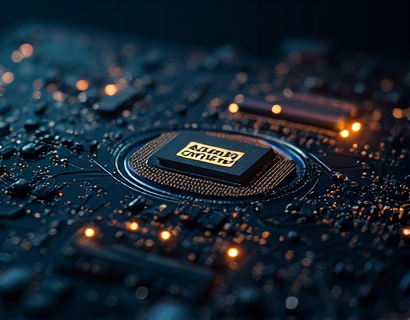Smart Contract Innovations for Pegged Stablecoins: Enabling Seamless DeFi Interactions
In the rapidly evolving landscape of decentralized finance, or DeFi, smart contract technology has emerged as a pivotal innovation, particularly in the creation and management of stable digital currencies pegged to leading tokens. This article delves into the transformative impact of these smart contracts, focusing on how they enable seamless bidirectional trading and enhance the stability and flexibility of DeFi interactions. By exploring the mechanics and benefits of this technology, we aim to provide a comprehensive understanding for cryptocurrency enthusiasts and DeFi innovators.
Smart contracts, self-executing contracts with the terms of the agreement directly written into code, have been a cornerstone of blockchain technology. However, their application in creating stablecoins pegged to a leading token represents a significant leap forward. These stablecoins, often referred to as pegged stablecoins, maintain a stable value by being backed by a reserve of a leading cryptocurrency, such as Ethereum or Bitcoin. The use of smart contracts in this context ensures that the peg is maintained automatically and transparently, reducing the risk of manipulation and enhancing trust in the system.
Mechanics of Pegged Stablecoins
The process of creating a pegged stablecoin involves several key steps, all facilitated by smart contracts. First, a reserve of the leading token is established, which serves as the backing for the stablecoin. Smart contracts are programmed to monitor the reserve and ensure that the number of stablecoins issued does not exceed the reserve value. This mechanism, known as a reserve lock, is crucial for maintaining the stability of the stablecoin.
When a user wants to create stablecoins, they initiate a smart contract transaction that locks a certain amount of the leading token in the reserve. In return, the smart contract issues an equivalent amount of stablecoins. Conversely, to redeem stablecoins for the leading token, a user triggers a smart contract that releases the locked tokens from the reserve and issues the corresponding amount of the leading token. This bidirectional process ensures that the stablecoin remains pegged to the leading token at all times.
Enhancing Stability and Flexibility
The use of smart contracts in pegged stablecoins significantly enhances the stability and flexibility of DeFi interactions. Traditional stablecoins rely on centralized entities to maintain the peg, which can introduce risks such as counterparty default or manipulation. Smart contracts eliminate these risks by automating the peg maintenance process, ensuring that the stablecoin's value remains tied to the leading token without the need for a central authority.
Moreover, the transparency and immutability of blockchain technology provide an additional layer of security. All transactions and the status of the reserve are recorded on the blockchain, allowing users to verify the stability of the stablecoin at any time. This level of transparency builds trust among users and participants in the DeFi ecosystem.
Bidirectional Trading and Liquidity
One of the most significant advantages of smart contract-based pegged stablecoins is the facilitation of seamless bidirectional trading. Users can easily convert stablecoins to the leading token and vice versa without intermediaries, reducing transaction costs and increasing efficiency. This bidirectional flow of assets enhances liquidity in the DeFi space, making it easier for users to participate in various financial activities such as lending, borrowing, and trading.
Smart contracts automate the conversion process, ensuring that the trade is executed instantly and accurately. For instance, when a user wants to exchange stablecoins for the leading token, a smart contract automatically checks the reserve, deducts the stablecoins, and issues the corresponding amount of the leading token. The reverse process is equally straightforward, ensuring that users can manage their assets with minimal friction.
Use Cases in DeFi
The integration of smart contract-based pegged stablecoins into DeFi protocols opens up a wide range of use cases. One prominent application is in decentralized lending and borrowing platforms. Users can lock their stablecoins as collateral to borrow other assets, with the smart contract ensuring that the collateral remains sufficient to cover the loan. This mechanism reduces the risk of default and enhances the overall stability of the lending system.
Another use case is in decentralized exchanges (DEXs), where pegged stablecoins serve as a stable trading pair for other assets. The predictability of the stablecoin's value reduces price volatility, making it easier for traders to execute strategies and manage risk. Smart contracts ensure that trades are executed fairly and transparently, further enhancing the user experience.
Challenges and Considerations
While the benefits of smart contract-based pegged stablecoins are substantial, there are also challenges and considerations that need to be addressed. One key issue is the potential for smart contract vulnerabilities. Any bugs or security flaws in the code can be exploited, leading to loss of funds or disruption of the peg. Therefore, rigorous testing and auditing of smart contracts are essential to ensure their reliability and security.
Another consideration is the governance of the reserve. Ensuring that the reserve is managed transparently and that there are mechanisms to handle unexpected events, such as a sudden drop in the leading token's price, is crucial. Decentralized governance models can play a role in this, allowing the community to participate in decision-making processes related to the stablecoin's management.
Future Prospects
The future of pegged stablecoins backed by smart contracts looks promising, with ongoing innovations set to further enhance their functionality and adoption. One area of development is the integration of oracles, which provide real-time data to smart contracts, enabling them to adjust the peg dynamically in response to market conditions. This can help maintain the stability of the stablecoin even in volatile markets.
Additionally, the interoperability of different blockchain platforms is becoming increasingly important. Cross-chain solutions that allow pegged stablecoins to be used across multiple ecosystems can expand their utility and reach, fostering a more interconnected DeFi landscape.
Conclusion
Smart contract innovations for pegged stablecoins represent a significant advancement in the DeFi space, offering secure, efficient, and user-friendly solutions for digital currency management. By automating the peg maintenance process and enabling seamless bidirectional trading, these smart contracts enhance the stability and flexibility of DeFi interactions. As the technology continues to evolve, it is poised to play an increasingly vital role in the modern economy, providing robust and intuitive financial tools for cryptocurrency enthusiasts and DeFi innovators alike.










































